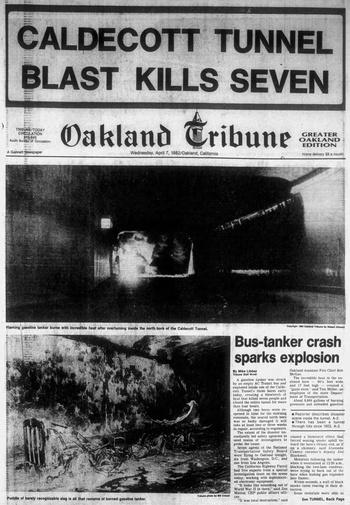The Caldecott Tunnel Fire occurred on the night of April 7, 1982 at 12.20 a.m. when a drunk driver struck the wall of the north tube of the Caldecott Tunnel between Oakland and Orinda leading to a chain of events that killed seven people and injured two.
Following the initial accident, a gasoline double tanker carrying 8,800 gallons followed by an AC Transit bus entered the tunnel. The tanker hit the disabled car and the bus hit either the tanker and/or the car and the bus driver was thrown from the vehicle and killed. The bus exited the tunnel without a driver before crashing into an overpass. The tanker began leaking gas and the driver ran safely out of the tunnel.
More cars entered the tunnel, in which the gasoline was flowing down the drains. Most of the cars were able to reverse out of the tunnel, but four vehicles (two pickup trucks, a beer truck, and a car) were trapped behind the tanker, which was on fire. June Rutledge, founder of the Piedmont Historical Society and her son Stephen Rutledge got out of their trapped pickup truck and walked uphill in the tunnel to warn other drivers not to enter. June used one of the emergency phones in the tunnel to call for help, but was killed when a fireball flashed through the tunnel. Her son Steve was injured, but survived, as well as Paul Petroelje, the driver in a second pickup truck.
Katherine and George Lenz, the elderly couple in the trapped car were also killed, as was John Dykes, the bus driver, along with Everett Kidney and Melvin Young, the occupants of the beer truck. Janice Ferris, the drunk driver in the first stopped car died as well.
It took several hours to extinguish the fire.
 Photo by Bill Londagin, courtesy Dorothy Londagin
Photo by Bill Londagin, courtesy Dorothy Londagin
Aftermath
Gasoline flowed into the storm drains and some ended up in Lake Temescal. It had mostly evaporated within a few hours.
The tunnel itself was damaged by the intense fire, which was in excess of 1900F. Although the traffic was westbound, the natural air flow was to the east, so the worst damage was around the tanker truck and to the east of it. 2 The damage was repaired, and less than a week later, traffic once again flowed through the bore. It had a temporary 35 MPH speed limit, but most people ignored it and drove closer to the regular 50 MPH. 4
One result of the accident was the banning of tanker vehicles containing flammable liquids from the tunnel except during limited hours (3AM to 5AM) by Vehicle Code Section 31301. There was an existing law following a 1949 fire in the Holland Tunnel in New York, but it contained a loophole, "unless there is no practicable alternative" route. 3
When a fourth bore was opened in 2013, it included a number of safety features inspired by the 1982 disaster, including cross passages connecting to the third bore and more powerful ventilation fans. Additional cameras and signage were added to the existing bores as well. 5
Links and References
- Caldecott Tunnel Blast Kills Seven Oakland Tribune April 7, 1982 (p2)
- A morgue-like eeriness follows tunnel inferno Oakland Tribune April 7, 1982 (p2)
- Loophole eases tunnel use ban Oakland Tribune April 8, 1982
- Traffic rolls again through fire-scarred tunnel Oakland Tribune April 13, 1982 (p2)
- New Caldecott Tunnel bore has safety features inspired by deadly fire Oakland Tribune October 18, 2013
- Caldecott inferno still a burning memory Oakland Tribune April 7, 2007
- Oakland, CA Tanker And Bus Collision In Tunnel, Apr 1982 GenDisasters (via archive.org)
-
Report Faults 2 Drivers In Fiery Tunnel Crash New York Times May 26, 1982
-
Caldecott Tunnel fire Wikipedia
-
Pair Praised For Heroism After Fiery Tunnel Blast Spokane Chronicle April 8, 1982
-
Drunk Driver Possible Cause Of Tunnel Blast At Oakland Eugene Register-Guard April 21, 1982
-
Officials Probe Tunnel Inferno That Killed 7 Pittsburgh Press April 8, 1982





